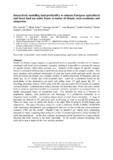JavaScript is disabled for your browser. Some features of this site may not work without it.
| dc.contributor.author | Audsley, Eric | |
| dc.contributor.author | Trnka, M. | |
| dc.contributor.author | Sabate, Santiago | |
| dc.contributor.author | Maspons, Joan | |
| dc.contributor.author | Sanchez, Anabel | |
| dc.contributor.author | Sandars, Daniel L. | |
| dc.contributor.author | Balek, Jan | |
| dc.contributor.author | Pearn, Kerry R. | |
| dc.date.accessioned | 2016-10-27T15:46:50Z | |
| dc.date.available | 2016-10-27T15:46:50Z | |
| dc.date.issued | 2014-07-01 | |
| dc.identifier.citation | Audsley, E. et. al (2014) Interactively modelling land profitability to estimate European agricultural and forest land use under future scenarios of climate, socio-economics and adaptation, Climatic Change, Vol. 128, Iss. 3-4, pp. 215-227 | en_UK |
| dc.identifier.issn | 0165-0009 | |
| dc.identifier.uri | http://dx.doi.org/10.1007/s10584-014-1164-6 | |
| dc.identifier.uri | http://dspace.lib.cranfield.ac.uk/handle/1826/10897 | |
| dc.description.abstract | Studies of climate change impacts on agricultural land use generally consider sets of climates combined with fixed socio-economic scenarios, making it impossible to compare the impact of specific factors within these scenario sets. Analysis of the impact of specific scenario factors is extremely difficult due to prohibitively long run-times of the complex models. This study produces and combines metamodels of crop and forest yields and farm profit, derived from previously developed very complex models, to enable prediction of European land use under any set of climate and socio-economic data. Land use is predicted based on the profitability of the alternatives on every soil within every 10' grid across the EU. A clustering procedure reduces 23,871 grids with 20+ soils per grid to 6,714 clusters of common soil and climate. Combined these reduce runtime 100 thousand-fold. Profit thresholds define land as intensive agriculture (arable or grassland), extensive agriculture or managed forest, or finally unmanaged forest or abandoned land. The demand for food as a function of population, imports, food preferences and bioenergy, is a production constraint, as is irrigation water available. An iteration adjusts prices to meet these constraints. A range of measures are derived at 10' grid-level such as diversity as well as overall EU production. There are many ways to utilise this ability to do rapidWhat-If analysis of both impact and adaptations. The paper illustrates using two of the 5 different GCMs (CSMK3, HADGEM with contrasting precipitation and temperature) and two of the 4 different socio-economic scenarios ("We are the world", "Should I stay or should I go" which have contrasting demands for land), exploring these using two of the 13 scenario parameters (crop breeding for yield and population) . In the first scenario, population can be increased by a large amount showing that food security is far from vulnerable. In the second scenario increasing crop yield shows that it improves the food security problem. | en_UK |
| dc.language.iso | en | en_UK |
| dc.publisher | Springer Verlag | en_UK |
| dc.rights | Attribution-Non-Commercial 3.0 Unported (CC BY-NC 3.0) You are free to: Share — copy and redistribute the material in any medium or format, Adapt — remix, transform, and build upon the material. The licensor cannot revoke these freedoms as long as you follow the license terms. Under the following terms: Attribution — You must give appropriate credit, provide a link to the license, and indicate if changes were made. You may do so in any reasonable manner, but not in any way that suggests the licensor endorses you or your use. Information: Non-Commercial — You may not use the material for commercial purposes. No additional restrictions — You may not apply legal terms or technological measures that legally restrict others from doing anything the license permits. | en_UK |
| dc.rights | This is an Accepted Manuscript of an article published by Taylor & Francis in Climatic Change on 01/07/2014, available online: http://www.tandfonline.com/10.1007/s10584-014-1164-6.” | en_UK |
| dc.title | Interactively modelling land profitability to estimate European agricultural and forest land use under future scenarios of climate, socio-economics and adaptation | en_UK |
| dc.type | Article | en_UK |
Files in this item
This item appears in the following Collection(s)
-
Staff publications (SWEE) [2880]
